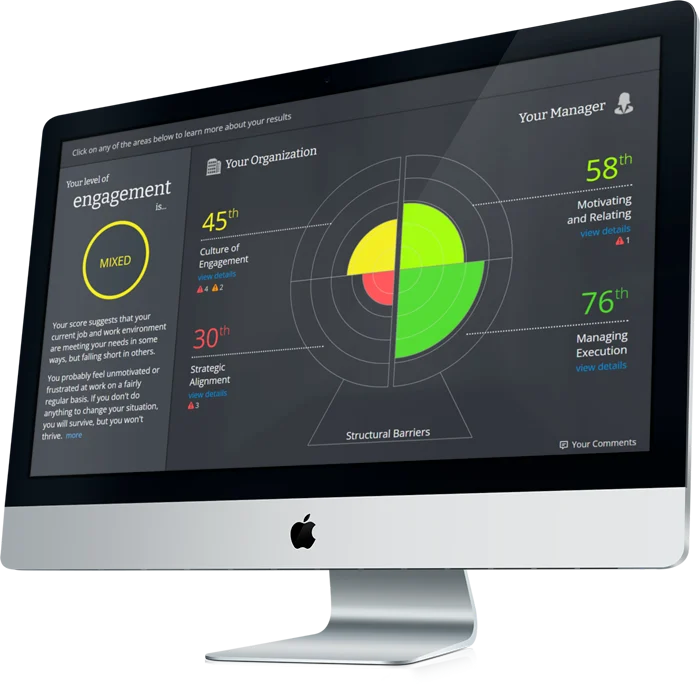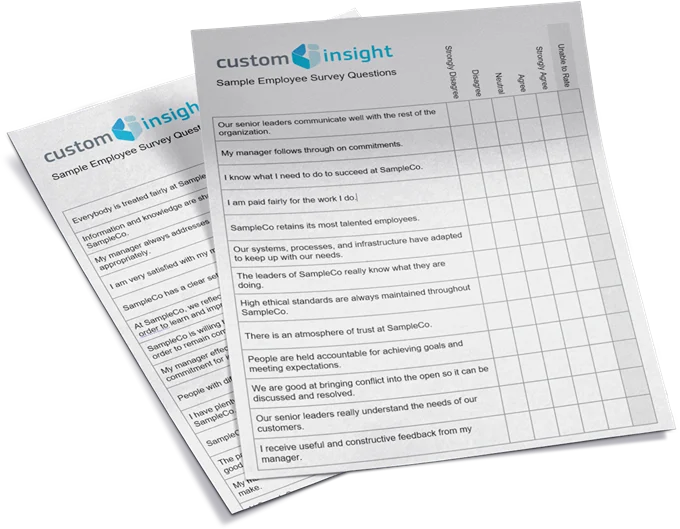In order to understand employee engagement in your organization, you have to start by asking the right questions.
Sample Employee Survey
Complete our short sample survey and receive a Personal Engagement Profile Report!

Employee Engagement
Survey Structure
How many questions should be included in an employee survey?
There are a lot of things that can impact your contributors' levels of engagement. Your questionnaire needs to cover all of the most critical areas, but it also needs to be as short as possible in order to maintain data quality and minimize the impact on the organization.
An engagement survey typically covers a fairly broad range of topics (see examples below). Comprehensive questionnaires can cover the most important engagement topics with 35 to 50 questions.
- 35-50 rating questions
- 5-point Likert rating scale
- Use mostly benchmarked items
- Include short-answer questions
- A few tailored follow-up questions
Very short surveys (e.g. 12 items) can do a great job of identifying whether people are engaged or disengaged, but they won't tell you why they are engaged or disengaged. This will leave you with more questions than answers when you try to understand what is driving employee engagement or disengagement in your workplace.
Longer questionnaires (e.g. more than 60 items) lead to lower participation rates and higher levels of "rater fatigue", where the quality of responses drops off as raters begin to spend less time carefully reading and thinking about their answers to the questions.
Should an engagement survey include Custom Questions?
It's fine to include custom questions if there are some specific areas that you want to explore. Just be sure to start with a strong foundation of statistically validated engagement items. Maintain the statistical integrity of those items by not changing the way they are worded. If there are areas that you feel are important, but that are not covered by the standard template, find out if there might be other questions in the survey item library that address those topics. Often, there will already be some statistically validated and benchmarked items available.
Keep in mind that custom questions can't be statistically validated, and they won't include benchmark scores. This can make it harder to know whether the results are positive or negative.
What Question Format Works best in an Employee Survey?
Most surveys use multi-point rating items, also called Likert scale items, for the numeric part of the questionnaire. The most popular format is a 5-point rating scale, with responses ranging from "strongly disagree" to "strongly agree".
Engagement surveys should also include qualitative feedback. Be sure to include short-answer questions so contributors can share their specific thoughts and concerns. Ask 3-5 short-answer questions at the end of the survey. Ask people what they are happy with as well as what causes them frustration. Examples of good short-answer questions are included below.
Collect demographic information using multiple choice questions at the end of the survey. Be sure to include an opt-out choice with each question for contributors who prefer not to answer. It's better to include demographic questions at the end because people will be more candid in their feedback if they have not already identified themselves. They can then decide whether they are comfortable answering some or all of the demographic questions at the end.
Sample Employee Survey Questions
Below are examples of items from an engagement questionnaire.
Items like these are available with benchmarks, which provide insight into how good or bad your results are.
Purpose and Direction
Feedback
Teamwork
Compensation
Workplace and Resources
Communication
|
Respect for Management
Respect for Employees
Opportunities for Growth
Work/Life Balance; Stress and Work Pace
Fairness
Performance and Accountability
Personal Expression / Diversity
|
Measuring Overall Employee Satisfaction and Employee Engagement
The examples below are questions that measure employee satisfaction or engagement more directly. These are the kinds of questions that very short surveys typically use. We don't use these kinds of questions in our engagement survey template for one simple reason - they are not actionable. These questions provide a good indication of whether contributors are satisfied or engaged, but they don't do a very good job of measuring why.- I am very satisfied with my job.
- I am highly committed to this organization.
- I would recommend this organization to friends and family.
- I am proud to tell people that I work for this organization.

